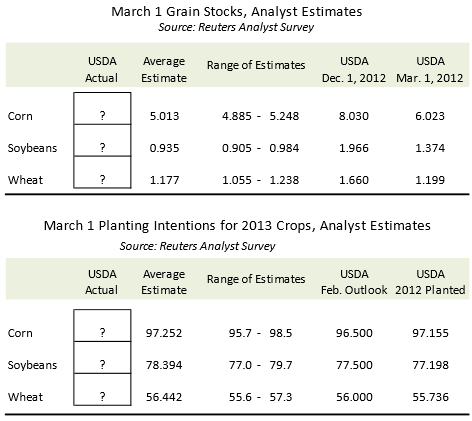On average analysts expect grain stocks as of 1 March to be 5.013 billion bushels. This implies a disappearance of about 3.070 billion bushels for the quarter. Corn export demand during the quarter was likely quite dismal probably around 175 million bushels. Ethanol production also was down signific antly during the quarter, probably around 13 per cent or so. Considering the decline in both ethanol and export demand, the average trade estimate of ending stocks implies that corn and residual during the Dec-Feb quarter probably was around 1.47 billion bushels, about 4.6 per cent below the same quarter a year ago (we have a 53 million bu. corn import number factored in).
The survey will confirm whether this expectation is warranted. Feedlot inventories have been down about 6 per cent from a year ago during the past quarter. Also, the increased use of more efficient feed additives has meant better conversion rates and heavier animals. However, the number of broilers coming to market in the last quarter was higher than a year ago while the number of hogs was about the same. The 6 per cent decline in feedlot inventories likely is not enough to account for the 4.6 per cent reduction in feed use implied in the quarterly corn balance sheet. Some wheat feeding certainly took place but again, there is plenty of uncertainty coming into the report as higher than expected feeding rates imply more rationing will be required in the next two quarters.
While the grain stocks survey will impact mostly old crop corn and soybeans, the planting intentions survey affects deferred grain futures and implicitly livestock and poultry production. USDA indicated in the February outlook forum that it expects farmers to plant about 96.5 million acres with corn. Private analysts, however, expect even more acres to go into production. Some areas of the country that normally are not big corn producers are expected to plant more corn and the marginal increases are expected to push total planted acres at near 97.3 million acres (average of analysts).
If this number ends up being correct, it would represent the largest number of corn acres planted since 1936 but only slightly higher than the acres planted last year. As last year showed, planting a lot of acres does not guarantee a record crop but, if weather conditions permit, the big plantings should help improve the corn balance sheet. As the lower table below shows, trade expects year over year planting increases in all three major crops.

Wheat plantings, which includes both winter wheat planted last fall and spring wheat to be planted this spring, are expected to be up by 1.3 per cent from a year ago. However, the expectation is that a significant number of winter wheat acres, probably as much as 20-25 per cent of the hard-red winter wheat acres (29.1 million) will be abandoned. Soybean plantings also are expected to increase 1.5 per cent. Combined corn, wheat and soybean acres this spring are expected to be up about 2 million acres from a year ago.
The Prospective Plantings report will provide one of the first indications as to the kind of corn supply and pricing that we should expect for the 2013-14 marketing year. In its February outlook meetings, USDA used a trend yield of 163.5 million bushels for the upcoming year. With 97.3 million corn acres planted, this kind of yield would cause corn production next fall to jump by about 3.9 billion bushels (+36 per cent).
That kind of an increase could push corn prices well below $5 per bushel, and likely below $4 per bushel. But it is a big if at this moment and a possibility that many in the market prefer not to bet on. But even a 10 bushel departure from trend (153 bu. acre) would still yield a gain of almost 3 billion bushels (+27 per cent). Some of the extra supply would likely quickly be absorbed by both ethanol and export markets. The latter is especially interested in more US corn. Still, that kind of increase would most certainly push corn prices back in the $5 per bushel territory. The only thing needed now is for some good growing weather to show up.





